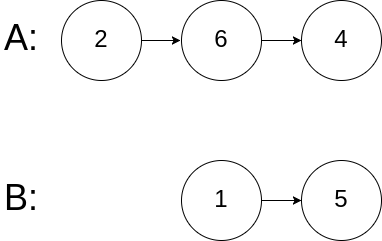Write a program to find the node at which the intersection of two singly linked lists begins.
For example, the following two linked lists:

begin to intersect at node c1.
Example 1:

Input: intersectVal = 8, listA = [4,1,8,4,5], listB = [5,0,1,8,4,5], skipA = 2, skipB = 3 Output: Reference of the node with value = 8 Input Explanation: The intersected node's value is 8 (note that this must not be 0 if the two lists intersect). From the head of A, it reads as [4,1,8,4,5]. From the head of B, it reads as [5,0,1,8,4,5]. There are 2 nodes before the intersected node in A; There are 3 nodes before the intersected node in B.
listA:41845
listB:501845
listAlistB:41845501845
listBlistA:50184541845
Example 2:

Input: intersectVal = 2, listA = [0,9,1,2,4], listB = [3,2,4], skipA = 3, skipB = 1 Output: Reference of the node with value = 2 Input Explanation: The intersected node's value is 2 (note that this must not be 0 if the two lists intersect). From the head of A, it reads as [0,9,1,2,4]. From the head of B, it reads as [3,2,4]. There are 3 nodes before the intersected node in A; There are 1 node before the intersected node in B.
Example 3:

Input: intersectVal = 0, listA = [2,6,4], listB = [1,5], skipA = 3, skipB = 2 Output: null Input Explanation: From the head of A, it reads as [2,6,4]. From the head of B, it reads as [1,5]. Since the two lists do not intersect, intersectVal must be 0, while skipA and skipB can be arbitrary values. Explanation: The two lists do not intersect, so return null.
Notes:
- If the two linked lists have no intersection at all, return
null. - The linked lists must retain their original structure after the function returns.
- You may assume there are no cycles anywhere in the entire linked structure.
- Your code should preferably run in O(n) time and use only O(1) memory.
https://www.cnblogs.com/yuzhangcmu/p/4128794.html
https://www.cnblogs.com/grandyang/p/4128461.html
https://zhuanlan.zhihu.com/p/32997648
Two pointer solution (O(n+m) running time, O(1) memory):
Maintain two pointers pA and pB initialized at the head of A and B, respectively. Then let them both traverse through the lists, one node at a time.
When pA reaches the end of a list, then redirect it to the head of B (yes, B, that's right.); similarly when pB reaches the end of a list, redirect it the head of A.
If at any point pA meets pB, then pA/pB is the intersection node.
To see why the above trick would work, consider the following two lists: A = {1,3,5,7,9,11} and B = {2,4,9,11}, which are intersected at node '9'. Since B.length (=4) < A.length (=6), pB would reach the end of the merged list first, because pB traverses exactly 2 nodes less than pA does. By redirecting pB to head A, and pA to head B, we now ask pB to travel exactly 2 more nodes than pA would. So in the second iteration, they are guaranteed to reach the intersection node at the same time.
If two lists have intersection, then their last nodes must be the same one. So when pA/pB reaches the end of a list, record the last element of A/B respectively. If the two last elements are not the same one, then the two lists have no intersections.
我们让两条链表分别从各自的开头开始往后遍历,当其中一条遍历到末尾时,我们跳到另一个条链表的开头继续遍历。
两个指针最终会相等,而且只有两种情况,一种情况是在交点处相遇,另一种情况是在各自的末尾的空节点处相等。为什么一定会相等呢,因为两个指针走过的路程相同,是两个链表的长度之和,所以一定会相等。这个思路真的很巧妙,而且更重要的是代码写起来特别的简洁,
You can prove that: say A length = a + c, B length = b + c, after switching pointer, pointer A will move another b + c steps, pointer B will move a + c more steps, since a + c + b + c = b + c + a + c, it does not matter what value c is.
Pointer A and B must meet after a + c + b (b + c + a) steps.
If c == 0, they meet at NULL.
public ListNode GetIntersectionNode(ListNode headA, ListNode headB) { bool resetA = false; bool resetB = false; ListNode resultListNode = null; if (headA == null || headB == null) { } else { var nodeA = headA; var nodeB = headB; while (true) { if (nodeA == nodeB) { resultListNode = nodeA; break; } else { nodeA = nodeA.next; nodeB = nodeB.next; if (nodeA == null && !resetA) { nodeA = headB; resetA = true; } if (nodeB == null && !resetB) { nodeB = headA; resetB = true; } } } } return resultListNode; }